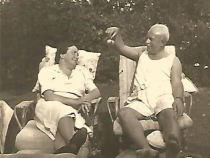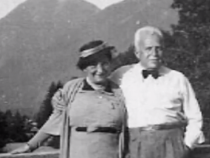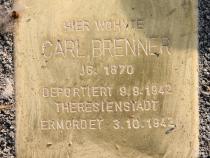Location
Thomasiusstraße 15
District
Moabit
Stone was laid
24 June 2015
Born
28 January 1870 in Schulitz (Westpreußen) / Solec Kujawski
Occupation
Großhändler für Kleiderstoffe
Deportation
on 09 September 1942
to the
KZ Theresienstadt
Murdered
03 October 1942 in Theresienstadt
Merchant Carl Callmann Brenner was born in 1870 in Schwetz, located on the Vistula river, just south of Danzig. He was married to Paula Nothmann, who was from Neisse, Silesia. In 1908 the Brenners started up a family, with the birth of their son, Walter. In 1911 the Brenner family moved to Thomasiusstraße 15.
Carl Brenner had a brother who was living diagonally across from them at Thomasiusstraße 7. Carl Brenner was a skilled businessman. In 1903 he and a partner had founded “Brenner & Nathan”, a wholesale garment fabric business, located at Poststrasse 28, in the Nikolaiviertel district. They had about 20 employees.
In 1937, because they were Jews, the Brenners were forced by the authorities to sell their business to non-Jews. That same year, their son Walter fled from Brandenburgstrasse (now Lobeckstraße) in Kreuzberg, to the USA. The Brenners also then tried to get out of Germany. The letters to their son were full of love and concern for his wellbeing. However, with the never-ending requests for additional documentation, the Brenners’ plans and hopes for exit visas began to fade. Their financial ability to escape really shrank as a result of the many taxes imposed by the Nazis, such as the so-called Jewish property tax. In addition, the Brenners would have to deposit the so-called “Reich Flight Tax”, equivalent to 25% of their total assets. In 1941, just as the Brenners thought they would finally make it out to the USA via Cuba, they were required to wait for “confirmation papers”. Now escape from Germany was no longer possible.
On September 9, 1942, the Brenners were deported to Theresienstadt on the “age 60 and over transport”. Carl Brenner was murdered a few weeks later. Paula survived two more years in the camp and was deported on July 15, 1944 to Auschwitz-Birkenau extermination camp, where she was murdered.
Son Walter started a family and later on moved to Israel. A niece of the Brenners survived several concentration camps and was later able to get out to Sweden, and then the USA, where she died in 1999.
Carl Brenner had a brother who was living diagonally across from them at Thomasiusstraße 7. Carl Brenner was a skilled businessman. In 1903 he and a partner had founded “Brenner & Nathan”, a wholesale garment fabric business, located at Poststrasse 28, in the Nikolaiviertel district. They had about 20 employees.
In 1937, because they were Jews, the Brenners were forced by the authorities to sell their business to non-Jews. That same year, their son Walter fled from Brandenburgstrasse (now Lobeckstraße) in Kreuzberg, to the USA. The Brenners also then tried to get out of Germany. The letters to their son were full of love and concern for his wellbeing. However, with the never-ending requests for additional documentation, the Brenners’ plans and hopes for exit visas began to fade. Their financial ability to escape really shrank as a result of the many taxes imposed by the Nazis, such as the so-called Jewish property tax. In addition, the Brenners would have to deposit the so-called “Reich Flight Tax”, equivalent to 25% of their total assets. In 1941, just as the Brenners thought they would finally make it out to the USA via Cuba, they were required to wait for “confirmation papers”. Now escape from Germany was no longer possible.
On September 9, 1942, the Brenners were deported to Theresienstadt on the “age 60 and over transport”. Carl Brenner was murdered a few weeks later. Paula survived two more years in the camp and was deported on July 15, 1944 to Auschwitz-Birkenau extermination camp, where she was murdered.
Son Walter started a family and later on moved to Israel. A niece of the Brenners survived several concentration camps and was later able to get out to Sweden, and then the USA, where she died in 1999.






